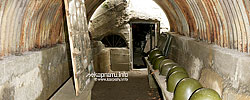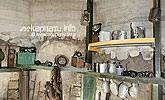Arpad Line Museum
'Arpad Line' is a museum of military history, where you can see a unique collection of equipment dated back to the times of WWII. The exposition also presents restored bunkers of that period, available for visitors. To date, four bunkers have been opened, with well-preserved construction elements (foundations, walls, ceiling elements).
The first bunker represents a commander's office, and is fully restored now. The exhibition inside displays original items, such as a machine gun, different types of rifles, cartridges and grenades, helmets and a farsight device, a flamethrower and a fire extinguisher, etc.
The second bunker was previously an outpost, from where the observation of territory was held.
Couple of metres far from those, there's a hospital bunker, with three-level bunk beds, medical equipment and still present odours of medicine, such as bromine iodine tincture. People couldn't stand being there for a very long time, but it was a quite appropriate place for taking care of injured soldiers and preparing them for evacuation. There are some old wind musical instrunemts which accompained the last journey of those who passed away.
A military kitchen bunker is located 100 m further. One very remarkable item there is a Hungarian camp stove called shpor. There's also a big soldiers' table with typical for those times kitchen unensils on it, such as stainless spoons and plates and copper mugs. Around the table are benches and sacks with food stores. The date on the sacks says '1942'.
Total amount of exhibits in the museum is over 2 thousand. In Kolochava there's also a defensive anti-tank line restored and available for visitors. It's made of concrete pyramids and is 100 m long, which makes it the longest one in Europe.
Some history of the matter:
The Arpad Line was started to be built by Hungarian government in 1940, and was aimed to protect the area against advancing Soviet troops. The geography of the region allowed to construct military fortifications, from which artillery fire could stop the movement of the enemy. It resulted in building in Kolochava about 30 reinforced concrete bunkers. Fortified trenches were dug, connecting firing points and bunkers with telephone lines. The firing points were equipped with automatic small arms, mortars, grenades and light anti-tank guns. As a part of fortified line, the Tereblia river was blocked in some places with several rows of concrete pyramids, some of which had been preserved till today in their original state. There are also separate pyramids gathered along the Tereblia, restored now by the museum staff and included in the exposition. Arpad Line is stretched along Transcarpathian region for 600 km. Interestingly, it didn't serve its original military purpose, as the Red Army found out about fortifications in the region and attacked from a different direction. When Hungarian army was leaving the place, the bunkers were blasted.
500 UAH (from 10 persons and more).
Visitors are allowed only with a guide.
Khust district
Kolochava village
Druzhba St., 26
Tel.: +38 (067) 238-09-85
+38 (067) 215-09-85
+38 (03146) 2-41-81
Go by any train of Uzhgorod direction to Volovets station, then take a bus to the centre of Kolochava.
Go by bus Lviv–Khust, Lviv–Tiachiv or Kyiv–Khust to Mizhgirya town, then take a bus to Kolochava. The museum is located nearby the main road when entering the village from Khust direction, on the right.
More information about public transport.
By car
Go along the road Kyiv–Lviv–Chop (M-06) and in Nyzhni Vorota village turn in Volovets direction and go to Mizhgirya, where you go along the main road and follow signs of Kolochava. The museum is located nearby the main road when entering the village from Khust direction, on the right.

 Ukraine
Ukraine Poland
Poland Slovakia
Slovakia
 Українською
Українською


































